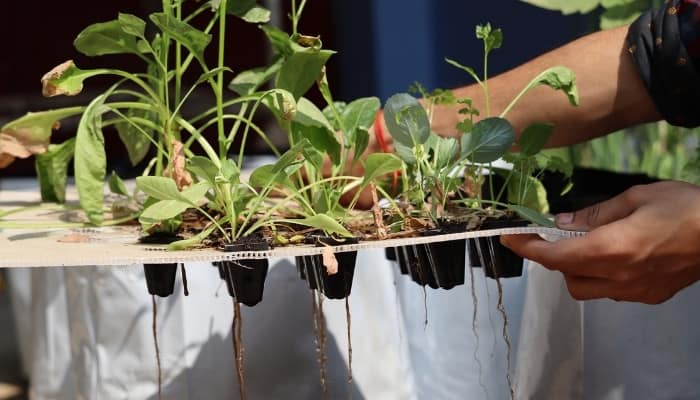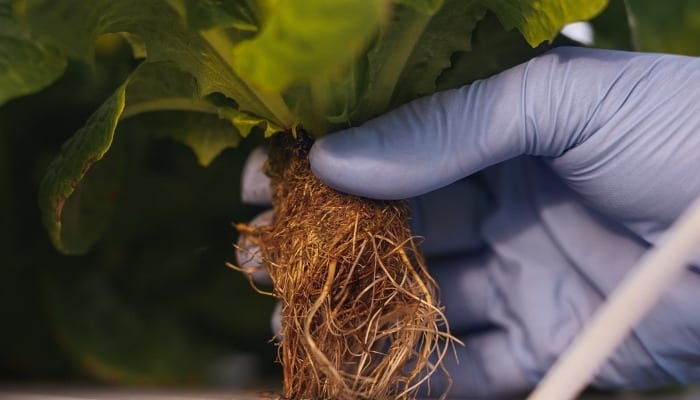One of the key differences between hydroponic gardening and traditional plant cultivation is the absence of soil. It can be frustrating to discover brown roots on your hydroponic plants, but what could be causing this issue?
Why are my hydroponic roots turning brown? Hydroponic roots typically turn brown due to root rot. This condition is brought on by the proliferation of fungi on roots that have been kept in overwatered and overly warm conditions, leading to decay and discoloration. Care and setup issues may also cause root browning.
Like traditionally grown plants, healthy hydroponic plant roots should be cream in color and feel firm to the touch.
To help them stay this way, let’s get accustomed to the common causes behind brown roots and how to deal with them…
7 Reasons for Brown Roots in Hydroponic Plants
Depending on the accompanying symptoms, brown roots can be a surface blemish or point to a more serious condition.
1. Root Rot
This is caused by a buildup of bacteria on roots that have been oversaturated and lack sufficient oxygenation.
- Identification – Drooping leaves, roots appear mushy and twisted, earthy odor.
- Solution – Remove plant from system, and cut mushy roots off with sterilized scissors. Rinse debris off remaining healthy roots and empty water reservoir for fresh, clean cycle.
- Prevention – Aerate your system and increase oxygen in the water using an air stone (this 2-pack is very affordable), and ensure your equipment is kept clean (check for algae/growing media buildup).
2. Nutrient Staining
Some hydroponic nutrient solutions on the market stain the roots, resulting in brown discoloration.
- Identification – Firm but discolored roots with no detectable odor. No change to outward plant appearance.
- Solution – Consider switching to a different brand of nutrient solution or adjust your concentration per gallon.
- Prevention – Staining is normal and can be unavoidable. As long as plants/roots appear healthy in every other respect (feeling firm to the touch with no earthy smell), staining is no cause for concern.
3. Brown Algae
Brown algae can appear on roots within the first month of a new reservoir setup and should abate in a few weeks. Algae spores that remain can point to environmental issues.
- Identification – Brown slime-like substance.
- Solution – Brush algae off affected root surfaces, and wash thoroughly in clean water. Maintain 65-85°F temps in your water reservoir, and aerate with air stones.
- Prevention – Use a dark, opaque reservoir vessel, and consider investing in a UV sterilizer to purify the water.
4. Lack of Oxygen
When water is kept too warm, the reservoir holds on to less dissolved oxygen for the plants to absorb.
- Identification – Softer roots but without an earthy odor (early stage of root rot).
- Solution – Trim the worst-affected roots, and increase dissolved oxygen in the reservoir using an air pump/air stone.
- Prevention – Keep your hydroponic setup cool by adding exhaust fans, and monitor water temps regularly.
5. Pythium
A fungal-like organism fostered by warm, poorly aerated conditions. Spores are spread by contaminated water, growing media, and tools/equipment.
- Identification – Mushy root texture. Nutrient solution may smell like rotten eggs (sulfur).
- Solution – Dump and refresh current reservoir water. Replace growing media and clean tools/equipment.
- Prevention – Maintain cooler water temperatures, and always use clean, sterilized tap water when mixing nutrient solution.
6. Recent Nutrient Change
Abruptly altering your nutrient solution concentration or using a new product altogether may stain roots or cause brown algae to develop.
- Identification – Murky/cloudy reservoir water. Possible pH change but no difference to plant appearance.
- Solution – Check if new nutrient solution turns cloudy in a smaller, separate batch. Add hydrogen peroxide (2-3 tsp/gallon) to your reservoir to help clear up potential algae.
- Prevention – Keep your setup aerated (externally with exhaust fans and with air stones in the water reservoir) and check nutrient strength.
7. Chemicals in Tap Water
Chlorine and other contaminants increase pH levels, making it harder for your plants to absorb nutrients since hydroponics were designed to work with neutral-pH levels.
- Identification – Stunted plant growth and wilting foliage.
- Solution – Try reducing your reservoir’s current pH level (see clip below), or place a UV sterilizer in the reservoir.
- Prevention – Leave tap water in an open container/bucket for 24 hours first to let chemicals evaporate.
Indications of Root Rot in Hydroponics
- Unpleasant earthy smell
- New leaves yellowing/turning pale
- Brown/dark spots on leaves
- Curling leaves with dead tips
- Weak/limp stems
- Overall stunted growth
Can Root Rot Be Reversed in Hydroponics?
Brown, mushy roots mean plants can’t recover, but if you detect symptoms early enough, you must try the following:
- Turn off the system, and rinse the roots under water before pruning infected sections with sterile scissors.
- Soak roots in a hydrogen peroxide/bleach solution for 12 hours. Meanwhile, drain and replace your nutrient solution.
- Once your system is up and running, add beneficial bacteria like Hydroguard to your reservoir – use 2 ml/gallon every cycle to help amplify root mass and vigor.
Do Brown Roots Always Mean Root Rot?

Roots must be both brown and mushy and accompanied by an earthy smell to indicate root rot.
Brown but firm roots, meanwhile, are usually the result of staining and will have “a herbal smell,” according to author of The Infinite Kitchen Amy Kerner.
How To Fix Root Rot in Hydroponics
The best fix for root rot is prevention by taking measures to ensure roots remain healthy and strong against fungal infections.
Things like ensuring your tools/setup are clean, oxygenating the water with air pumps/stones, and keeping your area (and reservoir temperature) cool are great steps.
Related Questions:
Do Hydroponic Roots Need To Be in the Dark?
Roots prefer darkness as overexposure to light results in algae growth and a green hue due to the chlorophyll.
It’s important to use a thick, opaque vessel for your water reservoir, like a black storage bin, and to use dark tubing to prevent light from entering and affecting root systems.
Should You Trim Hydroponic Roots?
Trimming hydroponic plant roots is necessary if they are infected or risk impeding system performance.
Routinely trim any dominant roots growing beyond the mass so they are roughly in equal length to each other. Do the same with overbearing vegetative roots so the root ball has even growth.
Conclusion
Brown hydroponic roots usually signal root rot, so early detection and action are key.
In the meantime, keeping your water reservoir aerated and within the 65-85°F range is good basic practice to sidestep root discoloration.

